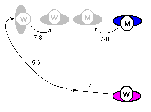|
Prexonera (or
Presoniera) is a dance by Domenico. It first appeared in his
manuscript De Arte Saltandi et Choreas Ducti, in
approximately 1450. It was learned and written up in a slightly
different form by Guglielmo in De Pratica seu Arte Tripudii.
The title of
the dance means “Prisoner”. The dance is for two people, one
man and one lady. In this dance the lady and man take turns in
capturing each other and holding each other prisoner. I take the
opinion that the dance would most probably have been done as a
performance dance -- the actions of the dancers are a play as much
as they are a dance.
I have
attempted to reconstruct the dance in a slightly different manner
to the way in which most dance reconstructions are done. Rather
than following the master’s instructions to the letter, I have
deliberately mis-reconstructed the dance in the manner that it
could possibly have been done by a pair of young dance students of
the time.
Improvisation
was still used fairly heavily in dancing in the 15th Century --
Domenico and Cornazano both offer chapters on body movement and
manner, but also indicate that variations of their mannerisms were
in common practice at the time they are writing (partly, in
admonishing the reader against these manners that are in error,
the masters admit that they are in common practice).
In this
reconstruction, I have taken Domenico’s description of the
dance, which basically includes feet movement only, and added some
body and hand movements that emphasise the play-acting nature of
the dance. I have enhanced the third figure of the dance, which
would otherwise be a straightforwards piva sequence with the
dancers moving side by side, into a game of cat-and-mouse, or more
correctly, captor and prisoner.
In doing this,
the dancers appear to be acting in a manner to be against some of
Guglielmo’s teachings -- in particular his “Rules for Women”.
Perhaps the more experienced (and older, and more demure) dancers
of Guglielmo’s class would not have done the dance in this
fashion, but some of the younger participants just might.
The result is, I hope, a dance that
although it disobeys some of the instructions laid out by
Guglielmo and Domenico, is a feasible interpretation of how the
dance could have been done as an entertainment piece in the
period.
|
 Two
contrapassi, or doubles on the same foot, on the left, in 1½
tempi, turning around to face the lady. The man should remain a
short distance away from the lady. Finish with a half tempo
pause.
Two
contrapassi, or doubles on the same foot, on the left, in 1½
tempi, turning around to face the lady. The man should remain a
short distance away from the lady. Finish with a half tempo
pause. This
section of the dance contains an element of acting. The dancers
should shy away from each other as they do the singles, and then
move in a more lively manner back towards their prisoner (or
captor) as they do the contrapassi.
This
section of the dance contains an element of acting. The dancers
should shy away from each other as they do the singles, and then
move in a more lively manner back towards their prisoner (or
captor) as they do the contrapassi.